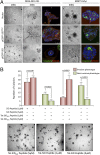Interference with Sin3 function induces epigenetic reprogramming and differentiation in breast cancer cells
- PMID: 20547842
- PMCID: PMC2900697
- DOI: 10.1073/pnas.1006737107
Interference with Sin3 function induces epigenetic reprogramming and differentiation in breast cancer cells
Abstract
Sin3A/B is a master transcriptional scaffold and corepressor that plays an essential role in the regulation of gene transcription and maintenance of chromatin structure, and its inappropriate recruitment has been associated with aberrant gene silencing in cancer. Sin3A/B are highly related, large, multidomian proteins that interact with a wide variety of transcription factors and corepressor components, and we examined whether disruption of the function of a specific domain could lead to epigenetic reprogramming and derepression of specific subsets of genes. To this end, we selected the Sin3A/B-paired amphipathic alpha-helices (PAH2) domain based on its established role in mediating the effects of a relatively small number of transcription factors containing a PAH2-binding motif known as the Sin3 interaction domain (SID). Here, we show that in both human and mouse breast cancer cells, the targeted disruption of Sin3 function by introduction of a SID decoy that interferes with PAH2 binding to SID-containing partner proteins reverted the silencing of genes involved in cell growth and differentiation. In particular, the SID decoy led to epigenetic reprogramming and reexpression of the important breast cancer-associated silenced genes encoding E-cadherin, estrogen receptor alpha, and retinoic acid receptor beta and impaired tumor growth in vivo. Interestingly, the SID decoy was effective in the triple-negative M.D. Anderson-Metastatic Breast-231 (MDA-MB-231) breast cancer cell line, restoring sensitivity to 17beta-estradiol, tamoxifen, and retinoids. Therefore, the development of small molecules that can block interactions between PAH2 and SID-containing proteins offers a targeted epigenetic approach for treating this type of breast cancer that may also have wider therapeutic implications.
Conflict of interest statement
The authors declare no conflict of interest.
Figures





References
-
- Ting AH, McGarvey KM, Baylin SB. The cancer epigenome—components and functional correlates. Genes Dev. 2006;20:3215–3231. - PubMed
-
- Frigola J, et al. Epigenetic remodeling in colorectal cancer results in coordinate gene suppression across an entire chromosome band. Nat Genet. 2006;38:540–549. - PubMed
-
- Fraga MF, et al. Loss of acetylation at Lys16 and trimethylation at Lys20 of histone H4 is a common hallmark of human cancer. Nat Genet. 2005;37:391–400. - PubMed
-
- Silverstein RA, Ekwall K. Sin3: A flexible regulator of global gene expression and genome stability. Curr Genet. 2005;47:1–17. - PubMed
-
- Schreiber-Agus N, et al. An amino-terminal domain of Mxi1 mediates anti-Myc oncogenic activity and interacts with a homolog of the yeast transcriptional repressor SIN3. Cell. 1995;80:777–786. - PubMed
Publication types
MeSH terms
Substances
Grants and funding
LinkOut - more resources
Full Text Sources
Other Literature Sources
Medical
Miscellaneous

